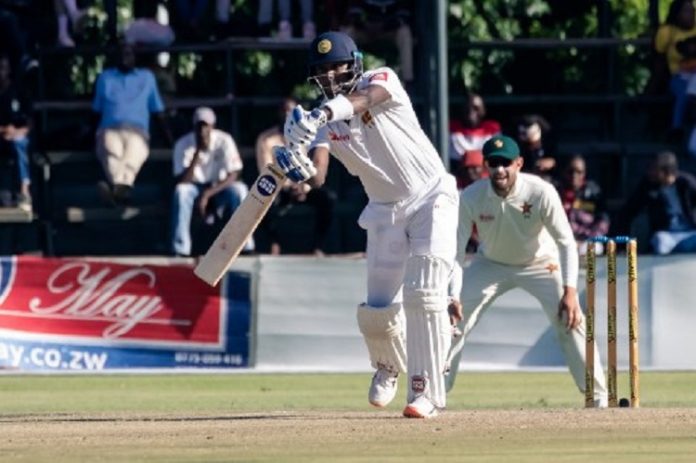The five-year drought for a Sri Lankan batsman without a double hundred has finally ended. Angelo Mathews joined the double hundred club this week, becoming the first Sri Lankan to do so since Kumar Sangakkara scored his 11th double hundred in windy Wellington five years ago.
Since then, Kusal Mendis and Dimuth Karunaratne had been dismissed in the 190s. Mathews was unconquered as the innings was declared with him on 200 not out.
The last year has been a pretty unproductive one for Mathews in Test cricket. Following his match saving hundred at the Basin Reserve, a hamstring injury ruled him out of the tours of Australia and South Africa. In 2019, he featured in four Test matches and managed just one half-century.
The Harare double hundred may not be classed as one of his better knocks given the opposition’s weak attack and a docile pitch but Mathews’ application and commitment needs to be lauded.
After all, his marathon lasted for ten hours. Against an attack that did not pose much threat, errors rather than quality of the deliveries were going to get you out. Mathews ensured that he did not commit any blunders. His strike rate early on in the innings was comical, barely touching 30. But then he cashed in with bowlers tiring and giving away loose balls frequently. In a game where no other batsmen reached three figures, Mathews application was remarkable. His effort ensured that this was a thrilling Test match that was stretched to the last hour of the game and all the more reason why Test cricket should be preserved in its present five-day format.
Time was when Mathews was ranked alongside Virat Kohli and Steve Smith as the best batsmen in the world following his prolific run scoring in 2014 and 2015. But from thereon, injuries, expectations and responsibility – all put together – have dented his effectiveness. Hopefully, he has turned a new leaf in his career.
With the series being run on a shoestring budget, there has been no television coverage and fans have to be content with the online streaming the host board put out. Zimbabwean cricket has fallen on troubled times and the country is making a comeback to international cricket after a suspension by the International Cricket Council due to political interferences.
But time was when Zimbabwean cricket was hale and hearty. Not too long ago, the country had the world’s best batsman in Andy Flower and he was backed up by brother Grant, presently Sri Lanka’s Batting Coach. The team compromised other match winners such as Murray Goodwin, Neil Johnson and Heath Streak.
Muttiah Muralitharan broke the World Record for most wickets in Test cricket for the first time in Harare when he overtook Courtney Walsh’s 519 mark in 2004.
A strong contingent of Sri Lankan media covered the historical moment and all of us returned home with fond memories.
Murali took eight wickets in the game and was named Man of the Match. His efforts, however, were overshadowed by some brutal power hitting by Sanath Jayasuriya, who posted 157 off 147 balls and shared a 281-run stand for the opening wicket with skipper Marvan Atapattu. It was Marvan’s first Test as captain and Sri Lanka completed an innings and 240-run win. Amidst the carnage, the game ended inside three days.
The team used up the two spare days to visit the majestic Victoria Falls on the Zimbabwe – Zambia boarder. The country as a whole is scenic and tourism used to be a major source of income. However, a few years ago, the controversial land reforms forced many white Zimbabweans to move to other parts of the world like Britain, Canada, Australia and South Africa and gradually the country lost its splendour.
The Harare Sports Club is right next the heavily guarded Presidential Palace of Robert Mugabe, who ruled Zimbabwe with an iron first for over three decades. The road between the Presidential Palace and the cricket ground was closed for public due to security reasons. But one of us took the chance by informing the commandos stationed at the top of the road that we had come to Zimbabwe to cover the cricket series. Upon checking our passports, the guards allowed us to use the road to enter the ground and for the next few days we had easy access to the stadium. That was a rare instance when the Sri Lankan passport came in handy.
This was during a period of golden era of Sri Lankan cricket and the team won all seven games of the tour. The second Test in Bulawayo produced an innings and 254 run win, to date Sri Lanka’s biggest win in Test cricket. Double hundreds by Kumar Sanakkara and Atapattu helped Sri Lanka post a total in excess of 700 and Zimbabwe were not good enough to match the opposition’s batting brilliance. In the ODIs that followed, Atapattu’s side whitewashed the hosts 5-0 to complete one of most successful tours undertaken by a Sri Lankan side.














